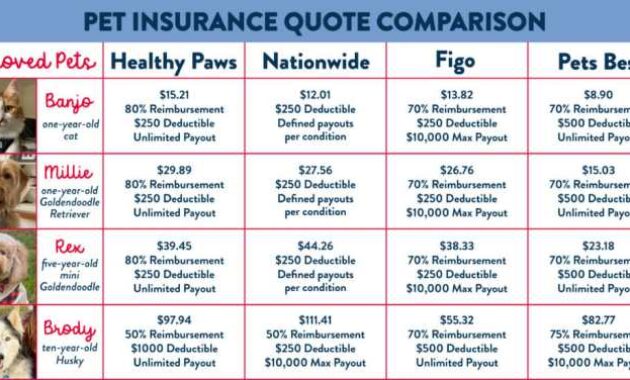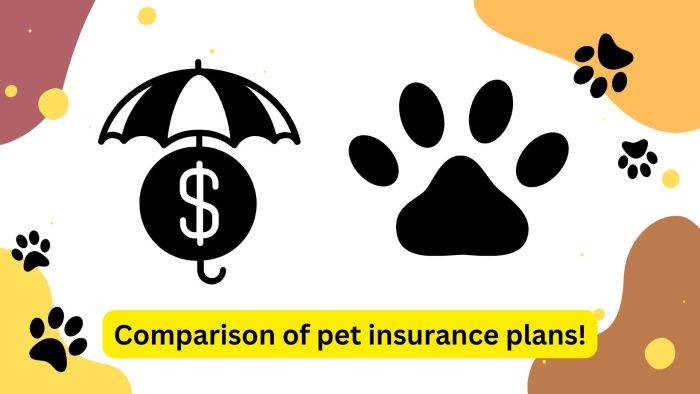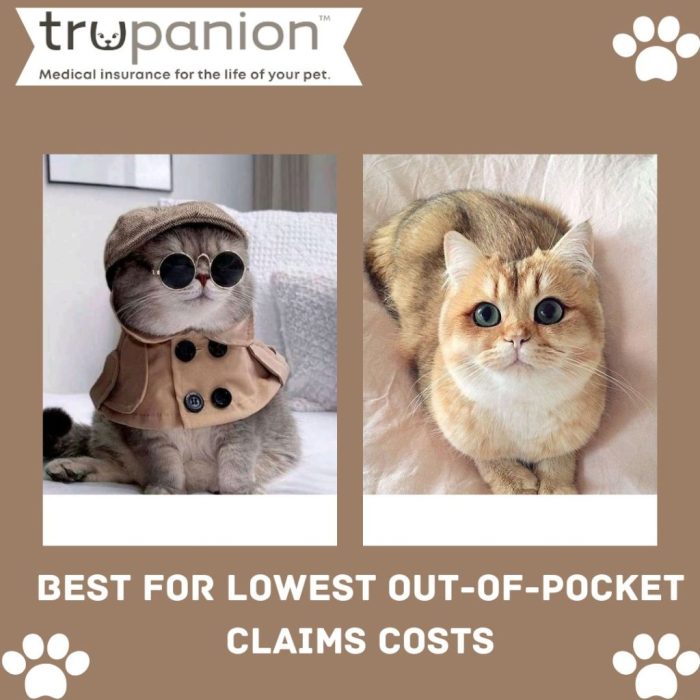
The unexpected illness or injury of a beloved pet can bring both emotional distress and significant financial burdens. Pet insurance plans offer a crucial safety net, mitigating these costs and allowing pet owners to focus on their animal’s well-being. This guide delves into the intricacies of various pet insurance plans, helping you navigate the options and make informed decisions to protect your furry, feathered, or scaled companion.
We’ll explore different plan types, factors influencing costs, the claims process, and crucial considerations when selecting a provider. Understanding the nuances of coverage, exclusions, and reimbursement methods is paramount to ensuring your pet receives the best possible care without jeopardizing your financial stability. This comprehensive overview aims to empower you with the knowledge needed to choose the pet insurance plan that best suits your pet’s needs and your budget.
Types of Pet Insurance Plans
Choosing the right pet insurance plan can feel overwhelming, given the variety of options available. Understanding the differences between various coverage levels is crucial to securing adequate protection for your beloved companion. This section will clarify the key distinctions between common plan types and highlight important considerations when making your selection.
Comparison of Pet Insurance Plan Types
The primary types of pet insurance plans are accident-only, accident and illness, and comprehensive. Each offers a different level of coverage and, consequently, a different price point. The choice depends largely on your budget and your pet’s health history and lifestyle.
| Plan Type | Coverage Details | Cost Factors | Pros/Cons |
|---|---|---|---|
| Accident-Only | Covers veterinary costs associated with accidents, such as broken bones, lacerations, and ingestion of foreign objects. Does not cover illnesses or pre-existing conditions. | Generally the least expensive option. Cost varies based on pet’s breed, age, and location. | Pros: Affordable. Cons: Limited coverage; doesn’t protect against illnesses. |
| Accident and Illness | Covers both accidents and illnesses, including common ailments like infections, allergies, and certain chronic conditions (depending on the policy). Pre-existing conditions are typically excluded. | More expensive than accident-only plans, but less costly than comprehensive plans. Cost influenced by factors similar to accident-only plans, plus the likelihood of illness in the breed. | Pros: Broader coverage than accident-only. Cons: Still excludes pre-existing conditions; can be costly depending on the pet and the specific plan. |
| Comprehensive | Offers the most extensive coverage, including accidents, illnesses, and often additional benefits like wellness care (routine checkups, vaccinations), alternative therapies, and behavioral consultations. Specific coverage varies widely between providers. | Most expensive option. Cost depends on the same factors as other plans, plus the level of additional benefits included. | Pros: Peace of mind; covers a wide range of veterinary expenses. Cons: High premiums; may still have exclusions and limitations. |
Variations in Coverage Among Insurers
Significant variations exist in the specific coverage offered by different pet insurance providers. These variations can include breed restrictions, where certain breeds deemed high-risk (e.g., some large breeds prone to hip dysplasia) may face higher premiums or be excluded altogether. Furthermore, nearly all providers exclude pre-existing conditions, meaning conditions diagnosed before the policy’s start date are generally not covered. The definition of “pre-existing” can vary between insurers, so careful review of policy wording is essential. Some insurers may offer coverage for certain pre-existing conditions after a waiting period, often 12 months, and proof of ongoing treatment. Finally, coverage limits, deductibles, and reimbursement percentages will differ widely.
Reimbursement Methods of Pet Insurance Providers
Pet insurance providers utilize various reimbursement methods. The two most common are percentage-based reimbursement and reimbursement with a cap.
| Provider (Example) | Reimbursement Method | Example |
|---|---|---|
| Provider A | 80% reimbursement up to a $5,000 annual limit | If a $1,000 veterinary bill is incurred, the provider would reimburse $800. However, if the annual limit is reached, no further reimbursements will be made for that year. |
| Provider B | 70% reimbursement with no annual limit | If a $1,000 veterinary bill is incurred, the provider would reimburse $700, regardless of how many bills are submitted during the year. |
| Provider C | Percentage-based reimbursement with per-incident cap | This combines both methods. For example, 90% reimbursement up to $500 per incident. If a $1,000 bill is incurred, the reimbursement would be $450. |
Factors Influencing Pet Insurance Costs
Choosing a pet insurance plan involves understanding the factors that contribute to the premium cost. Several key elements influence how much you’ll pay each month, and being aware of these can help you make informed decisions and potentially save money. This section will Artikel the major factors and provide examples of their impact.
Several key factors determine the premium cost of a pet insurance plan. These factors interact to create a unique price for each pet and policy. Understanding these factors is crucial for selecting a plan that fits your budget and needs.
Age of the Pet
A pet’s age is a significant factor in determining insurance costs. Younger animals generally have lower premiums because they are statistically less likely to require extensive veterinary care. As pets age, the risk of developing age-related health issues increases, leading to higher premiums. For example, a one-year-old dog might have a significantly lower premium than a seven-year-old dog of the same breed and with the same coverage. This is because older animals are more susceptible to conditions like arthritis, cancer, and kidney disease, all of which can be expensive to treat.
Breed of the Pet
Certain breeds are predisposed to specific health problems. Breeds known for inheriting conditions that require costly treatment will typically result in higher premiums. For instance, a German Shepherd, known for hip dysplasia, might have a higher premium than a Labrador Retriever, which generally enjoys better overall health. Similarly, breeds prone to specific cancers or eye conditions will reflect this increased risk in their insurance costs. This is a reflection of the statistical likelihood of needing veterinary care based on breed-specific health data.
Location
The geographic location where you live also impacts your pet insurance premium. Areas with higher veterinary costs will naturally lead to higher premiums. This is because insurance companies must account for the actual cost of care in different regions. A pet owner in a major metropolitan area with high veterinary costs might pay more than someone in a rural area with lower veterinary costs, even if all other factors are identical.
Coverage Level
The level of coverage you choose directly impacts the cost of your insurance. Comprehensive plans covering a wider range of conditions and treatments will be more expensive than basic accident-only plans. Choosing a plan with higher reimbursement percentages or lower deductibles will also increase your monthly premium. For example, a plan that reimburses 90% of veterinary bills will cost more than a plan that reimburses only 70%.
Discounts and Savings
Many pet insurance providers offer discounts to incentivize customers. These discounts can significantly reduce your overall costs.
- Bundled Services: Some companies offer discounts when you bundle pet insurance with other services, such as pet sitting or grooming.
- Loyalty Programs: Insurers may offer discounts for long-term policyholders, rewarding customer loyalty with reduced premiums.
- Multi-pet Discounts: Insuring multiple pets with the same provider often leads to a discount on the overall premium.
Claims Process and Reimbursement

Submitting a claim for reimbursement under your pet insurance policy is a crucial step in accessing the financial support you need for your pet’s veterinary care. Understanding the process and the necessary documentation will ensure a smooth and efficient claim experience. This section details the typical claims process, required documentation, and provides a step-by-step guide.
The claims process generally involves submitting your veterinary bills and other supporting documentation to your insurance provider. The insurer then reviews the claim, verifies the coverage, and processes the reimbursement. The time it takes to receive reimbursement can vary depending on the insurer and the complexity of the claim. Some insurers offer online portals for easy claim submission, while others may require you to mail in the necessary paperwork.
Required Documentation for Pet Insurance Claims
To ensure a successful claim, you’ll need to provide comprehensive documentation to your insurer. This typically includes the original veterinary bills detailing the services rendered, a diagnosis of your pet’s condition from your veterinarian, and any other relevant medical records. Failure to provide complete documentation may lead to delays or rejection of your claim. It’s also important to check your policy for specific requirements as they can vary between providers. For example, some insurers may require pre-authorization for certain procedures.
Step-by-Step Guide to the Pet Insurance Claims Process
A typical pet insurance claims process can be broken down into these key steps:
- Gather Necessary Documentation: Collect all original veterinary bills, diagnostic reports, and any other relevant medical records pertaining to your pet’s treatment. Ensure all information is clearly legible and complete.
- Submit Your Claim: Submit your claim through your chosen method (online portal, mail, or fax). Many providers offer online claim forms for convenience. Carefully review the claim form and ensure all required information is accurately completed.
- Claim Review and Verification: The insurance company will review your claim and verify the information provided against your policy coverage. This may involve contacting your veterinarian for clarification if necessary.
- Reimbursement Processing: Once the claim is approved, the insurance company will process your reimbursement. The timeframe for reimbursement varies depending on the provider but is typically within a few weeks. The reimbursement amount will be based on your policy’s terms and conditions, including the deductible, co-pay, and reimbursement percentage.
- Receive Reimbursement: You will receive your reimbursement via check or direct deposit, depending on your insurer’s payment method. You should receive a notification of payment alongside the reimbursement itself.
Choosing the Right Pet Insurance Provider

Selecting the right pet insurance provider is crucial for ensuring your furry friend receives timely and comprehensive veterinary care without breaking the bank. The market offers a wide array of options, each with its own strengths and weaknesses. Careful consideration of several factors will help you make an informed decision that best suits your pet’s needs and your budget.
Comparison of Pet Insurance Providers
Choosing a provider involves comparing various aspects of their services. The following table compares three major providers, but remember that specific plans and pricing can vary significantly. Always check the latest information directly with the providers.
| Provider Name | Coverage Options | Customer Service Rating (Example – based on online reviews and surveys; not a definitive rating) | Claim Processing Speed (Example – average processing time based on reported experiences; not a definitive measure) |
|---|---|---|---|
| Provider A (Example: Nationwide) | Accident-only, accident and illness, wellness plans; various deductible and reimbursement options. | 4.2 out of 5 stars | 5-7 business days |
| Provider B (Example: Trupanion) | Accident and illness coverage; reimbursement typically based on actual veterinary costs. | 4.0 out of 5 stars | 3-5 business days |
| Provider C (Example: Healthy Paws) | Accident and illness coverage; various deductible and reimbursement percentage options. | 4.5 out of 5 stars | 2-4 business days |
Importance of Reading Policy Details
Before committing to any pet insurance plan, meticulously reviewing the policy’s fine print is paramount. This includes understanding the definitions of covered conditions, exclusions, waiting periods, annual limits, and the claims process. Overlooking crucial details can lead to unexpected costs and disappointments during a claim. For instance, pre-existing conditions are often excluded, and certain breeds might face limitations on coverage for specific illnesses. Paying close attention to the policy’s terms and conditions prevents unpleasant surprises later.
Finding a Reputable Pet Insurance Provider
Identifying a trustworthy and reliable pet insurance provider requires thorough research. Checking online reviews and ratings from independent sources provides valuable insights into customer experiences with different providers. Confirming the provider’s financial stability and licensing ensures they can meet their obligations. Seeking recommendations from veterinarians or other pet owners can also be helpful. Remember to compare quotes from multiple providers to find the best value for your specific needs and budget. A reputable provider will offer clear and transparent information about their policies and claims processes, readily accessible via their website or customer service channels.
Common Exclusions and Limitations
Pet insurance, while offering valuable protection, isn’t a complete guarantee of coverage for all veterinary expenses. Understanding common exclusions and limitations is crucial for pet owners to manage expectations and avoid unexpected costs. Policies often contain specific clauses that limit coverage, meaning some conditions or treatments won’t be reimbursed. This section will Artikel these key limitations.
Many pet insurance policies share similar exclusions and limitations, impacting the types of veterinary care that are covered. It’s vital to carefully review your policy’s specific wording to understand what is and isn’t included. Failure to do so could lead to unexpected out-of-pocket expenses when you need them least.
Pre-existing Conditions
Pre-existing conditions represent a significant limitation in most pet insurance policies. This refers to any illness, injury, or condition your pet had before the policy’s start date, or within a specified waiting period (often 14-30 days). Even if the condition resurfaces after the waiting period, it’s usually still excluded from coverage. This is because insurers assess the risk of covering pre-existing conditions as too high.
For example, if your dog had allergies before you enrolled them in a pet insurance plan, any treatment related to those allergies is unlikely to be covered, even if they flare up later. Similarly, a cat with a history of urinary tract infections would likely find treatment for future infections excluded. The implications for pet owners are clear: comprehensive pre-policy veterinary records are essential for ensuring that your pet is fully insured. Without such records, the insurer might have grounds to deny coverage, even for seemingly unrelated issues.
Routine Care
Most pet insurance plans exclude routine care, such as annual check-ups, vaccinations, flea and tick prevention, and dental cleanings. These are considered preventative measures, not treatments for illness or injury. While these services are vital for your pet’s health, they are generally not covered under standard pet insurance policies.
This exclusion is designed to keep premiums affordable. Including routine care would significantly increase the cost of insurance, making it less accessible to many pet owners. Therefore, pet owners should budget separately for these essential preventative services.
Breed-Specific Conditions
Certain breeds are predisposed to specific health problems. For example, German Shepherds are prone to hip dysplasia, while certain breeds of cats are at higher risk for hypertrophic cardiomyopathy. Some pet insurance providers may exclude or limit coverage for these breed-specific conditions, or they may charge higher premiums for breeds known to have more health issues.
This means that pet owners of predisposed breeds might find that treatment for these conditions is not covered, or that they face higher premiums to secure coverage. Understanding your pet’s breed and its associated health risks is important when selecting a pet insurance plan. Comparing policies and carefully reviewing exclusions related to breed is advisable before making a decision.
Conclusive Thoughts

Choosing the right pet insurance plan is a significant decision, requiring careful consideration of your pet’s breed, age, health history, and your financial capabilities. By understanding the various plan types, coverage options, and claims processes, you can make an informed choice that provides peace of mind knowing your pet will receive the necessary veterinary care, regardless of the circumstances. Remember to thoroughly review policy details and compare providers to find the best fit for your unique situation and your cherished companion.
Common Queries
What is a waiting period, and why does it exist?
A waiting period is a timeframe after purchasing a policy before certain types of coverage begin. This is common for pre-existing conditions and often exists to prevent people from buying insurance after their pet is already ill.
Can I change my pet insurance plan later?
Most insurers allow you to change your plan (upgrade or downgrade coverage) during the policy renewal period. Check your policy for specifics.
What happens if my pet is injured outside my home country?
Coverage for injuries or illnesses sustained outside your home country varies widely by insurer. Some policies offer limited international coverage, while others do not. Review your policy details carefully.
Are there any age limits for pet insurance?
Yes, many insurers have age limits, both for enrolling a pet and for continued coverage. Senior pets may have limited options or higher premiums.
How do I cancel my pet insurance policy?
Cancellation procedures vary by provider. Check your policy documents or contact your insurer directly for instructions; usually involves written notification.